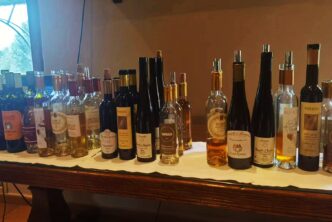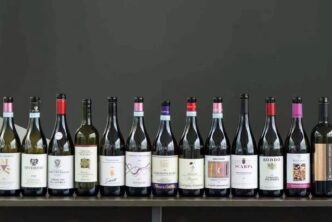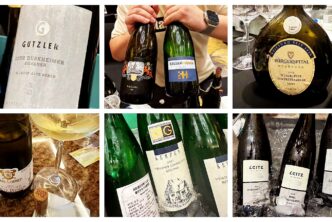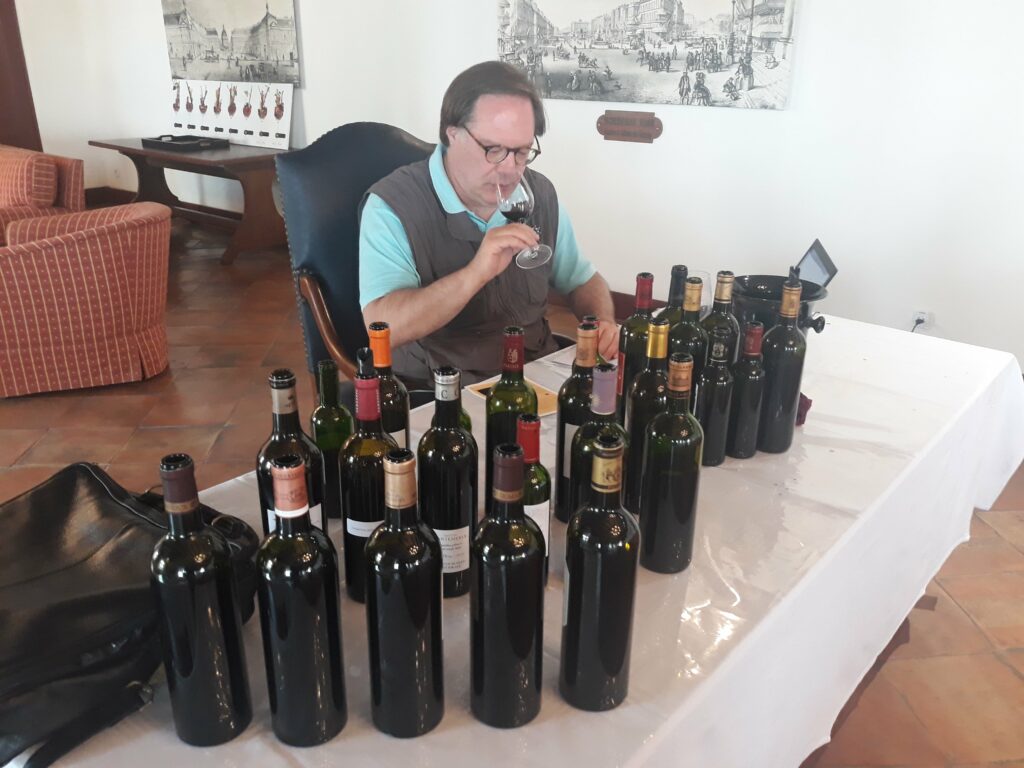
I have had a long-standing love affair with Bordeaux, its people, its food, its scenery, and its famous wines: simply put, Bordeaux is one of my three favourite non-capital cities in the world and I would love to live there (I have thought about doing so long and hard, and in fact almost did move there a few years ago). I have spent countless weekend vacations in the city over the last twenty years, not to mention visiting the Chateaux as many as five different times a year for the better part of those twenty years. And so it is that I have written about Bordeaux’s wines and covered the Primeurs annually both for Stephen Tanzer’s International Wine Cellar (IWC) and for Decanter (and Italian magazines before that), and never found the experience less than thrilling and totally enriching. Even better, and most importantly, is that I know the wines and the properties extremely well, as anyone who followed my very in-depth articles and vertical tasting reports at IWC and Decanter know only too well. I am therefore very happy to start writing about Bordeaux’s wines again on a highly regular basis, and once again covering the Primeurs annually, something I really missed doing during my five years. But Bordeaux was and really is one of my first wine loves (the first great wines I drank in my life were either Barolos, Mosel Rieslings or Bordeauxs), and as well all know and remember well, one never forgets his or her first love. And so, I’m back! Stay tuned then for many more Bordeaux regional reports and vertical tasting reports to be published in the upcoming weeks here at TerroirSense. In the meantime, I hope you enjoy my coverage of the 2019 Bordeaux left bank vintage.
The 2019 vintage’s growing season
The 2019 Bordeaux vintage weather began auspiciously enough with the sunniest February in memory, with temperatures four degrees Celsius higher than the previous thirty years annual average. The good weather continued in March, in which temperatures were one degree Celsius above average (with 35% more sunshine than the month’s average over the previous thirty years, and with 70% less rain). Bud break was early in 2019 (occurring about one week sooner than in 2018, for example) but was followed by three relatively cool and wet months: a sporadically wet and cool April, a colder but less rainy than usual May and one of the coolest and rainiest June’s on record of the last thirty years. There were frost scares (for example, on March 27 and 28, April 12 and 13, May 5 and 6) and frost did hit for example on April 12, damaging vines in localized areas, but overall damage in 2019 was not severe: only 5% of the region’s vineyard hectarage was affected by frost compared to almost 50% in 2017, for example. The cold and rain caused uneven flowering in spots during in June, but thankfully hot and mostly dry weather arrived to stay in the last ten days of June, guaranteeing a good fruit set (when it comes to wine, not all heat waves are bad, obviously). The hot and dry weather continued through July, August and September (for example, only 64 millimeters of rainfall were recorded from June 1 to September 15 in parts of Bordeaux), so both the ripening process and the harvest were successful. Caveats to that statement include a few water-logged days in July that made it tougher on vineyards planted on clay-rich soils, a hot July making it tough on strongly gravel soils, and relative drought in August (which was about seven degrees Celsius warmer compared to the average daily temperature recorded in August over the previous thirty years). All of which meant having to preserve humidity as much as possible by working over the soils extensively and keeping deleafing to a minimum. Rain fell at the end of August too and this time it was beneficial, especially to those gravel-rich areas where water stress might have otherwise become a big problem (and in fact was a problem, in parts of the Bordeaux Appellation). A little September rain delayed the Cabernet Sauvignon harvest, affording the grapes more hang time, while most of the Merlot had been picked before the September rains. Yields were good overall (just slightly off the previous 10 yearly average) but varied greatly between Appellations, ranging from the 10hL/ha of Sauternes to the 50 hL/ha of Saint-Estèphe.
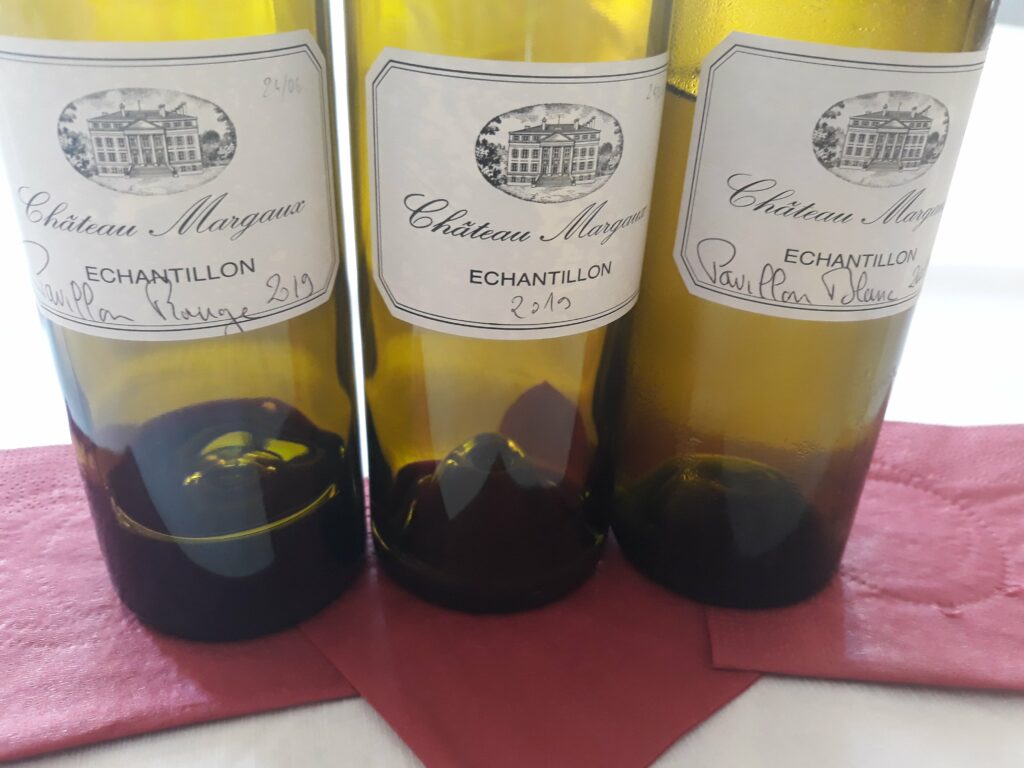
The individual Appellations and their wines
Saint-Estèphe was very successful in 2019, no doubt helped by the clay presence in the subsoil that allowed for better water storage capacity than some other Appellations more strongly marked by gravel soils. For the most part, 2019 strikes me as a vintage of earlier-maturing wines than usual for this Appellation; and some wines made with grapes on strongly gravel soils fared less well than usual, but for the most part quality was very consistent throughout the range of Saint-Estèphe wines I tried.
Pauillac and Saint-Julien both fared well in 2019, with a little less ill-timed rain with respect to other Appellations probably contributing to making a difference. And while Saint-Julien’s wines are beautifully silky and pure but also some of the most tannic young wines from this Appellation I have memory of, my award for “the most successful left bank Bordeaux Appellation in 2019” goes to Pauillac. There, even estates that had been quality laggards of late have made some of their best wines in years, plus all the top draws performed admirably. My tastings showed that Margaux also performed well, but with a larger number of wines showing potentially gritty tannins than in Pauillac or Saint-Julien. Last but not least, Pessac-Léognan made many exceptional wines, but ultimately achieving real success or not depended on the percentage of Merlot in the blends and just how ripe that Merlot was (parts of this appellation are close to Bordeaux’s city center and generally have a warmer mesoclimate than other Bordeaux appellations, posing an ulterior menace to Merlot that was at risk of giving slightly overripe, too high in alcohol wines in 2019).
The market
It’s impossible to speak and write of a brand new Bordeaux vintage without a look at what the markets are doing. It is a primeurs release, after all. Aback in early 2020, or at the beginning of what would have been a normal Bordeaux Primeurs campaign, things were not quite so rosy, as you might say the wind had been taken out not just of Bordeaux’s sails, but sales too. Compared to the same time period in 2018, 2019 Bordeaux wine sales (this data also includes right bank wines) had fallen by roughly 12%, with the biggest drop recorded in France (close to 10% in both volume and value). Export data gave contrasting information, and depended essentially on the specific country being analyzed: whereas numbers were down for China (around -15% in both export volume and value), the numbers were up for the United States in the initial part of the year (+5%) though the long running scare of tariffs that were long bandied about in 2020 (a truly miserable year on many accounts) by the US administration and finally levied clearly reverberated on these numbers. But the Bordeaux place reacted strongly and well, and it is to their immense credit if things have since turned out as well as they have. In short, the Bordeaux estates dropped their prices in significant fashion, and that simple but necessary step, coupled to what is unquestionably an excellent vintage, led to the wines selling well and quickly. For example, Christian Seely of Pichon Baron told me they did just that, and were rewarded for their actions. He was very pleased with how his sales went. At Lafon-Rochet, Michel Tesseron took much the same path, releasing his wine at 27 Euros ex-negociant, discounted 13.5% compared to his 2018. On June 9, the 2019 Mouton Rothschild was released at 282 Euros, which was not just more than 30% less than their 2018, but is admittedly and excellent, downright inviting price for a first growth. Pichon Lalande came out on June 22 at 104 Euros/bottle, or 21% less than the 2018, and the song was much the same for many other Bordeaux estates.
In conclusion…
There is no clearer way to say or write it than this: the 2019 left bank Bordeaux wines are excellent. Though not ideal, the growing season was quite good overall, and only those estates where the grape technological and polyphenol maturation curves differed greatly ended up producing slightly lesser wines than they might have otherwise. The summer drought in itself was not a major issue (the abundant water that had fallen in the early part of the growing season allowed for adequate reserves to be built up) save for younger vines with shorter rooting systems and those vineyards planted on extremely gravelly soils where drainage tends to be almost too good at times. And the strong July heat (with days reaching as much as forty degrees Celsius in Pauillac and 42 degrees Celsius in Pessac-Léognan) happened mostly before véraison (the colour change of the grapes) which ahs little effect on final wine structure and flavour. In my mind, a key feature of the vintage was the fall’s noteworthy diurnal temperature shift (there was as much as a twenty degree Celsius difference between days and nights at harvest time) explaining the bright perfume that characterizes the majority of the 2019 left bank wines.
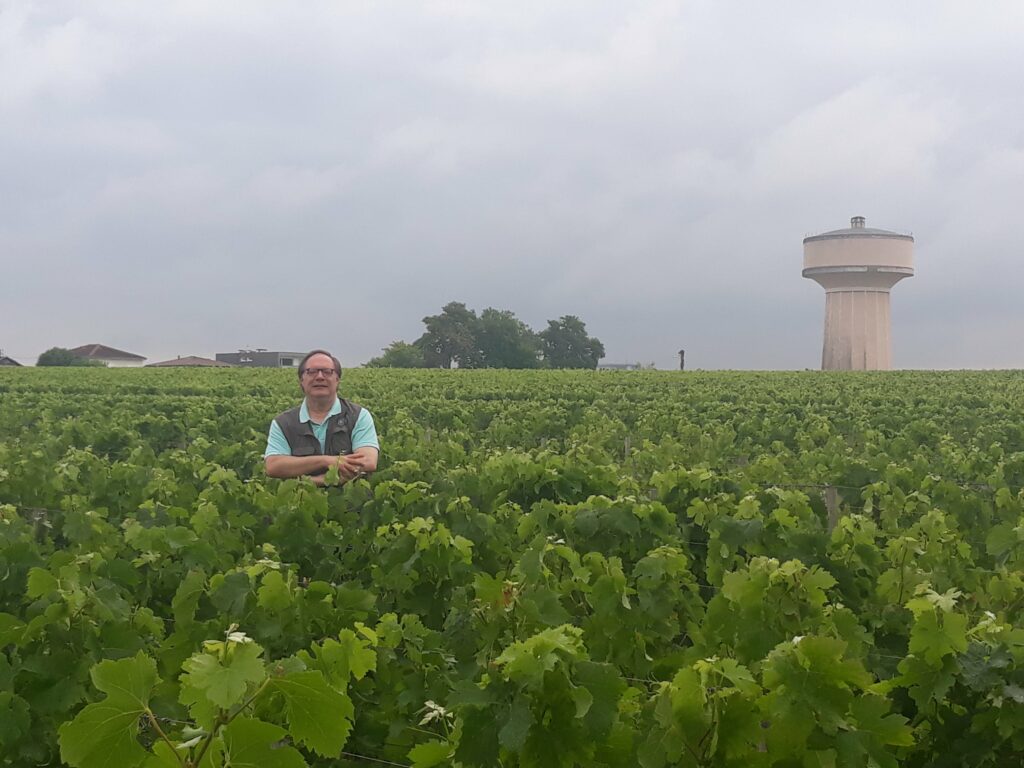
The grape variety that fared best on the left bank in 2019 is Cabernet Sauvignon (and Cabernet Franc, whatever little of it is left on the left bank). Merlot and Petit Verdot both experienced problems: the former ripened too quickly in various parts of the Appellations, presenting surging sugar concentrations and consequently wines marred by bloated alcohol levels, while the latter wine grape suffered from ill-timed lack of water (Petit Verdot is a variety that does not tolerate drought especially well). It follows that 2019 is a vintage of “true” Bordeaux wines: the whole is better than the individual parts, with the final blends benefiting from the contribution of each grape variety. My impression, as stated before, is that the 2019 left bank wines are excellent, in a classic perfume style that reminded me of purer 1988s and fruitier 2008s, both highly underrated, very classic vintages that I have always loved. But in fact, the 2019s are very much their own wines. Continuing the comparison with other recent Bordeaux left bank vintages, the classic personality of the 2019s is a polar opposite to the luscious, and at times downright opulent, style of the much loved and sought after 2009s or the also luscious and bigger 2015s. By contrast, the 2019s left bank wines are not that far behind the generally overrated 2010s in quality, but clearly are far less powerful wines (and of course, some left bank estates did make their best ever wines in 2010, which is something that no estate will ever say of their 2019s). Relative to more recent vintages, the 2019 wines boast some of the classicism of the 2016s, though not quite the same structure or personality at the same stage of development (at that time, the 2016s were more backwards and tighter), while the 2019s are talkative, charming wines, but certainly nowhere near as extravagant as the 2018s.
In ultimate analysis, I think that 2019 is an excellent Bordeaux vintage loaded from top to bottom with many outstanding wines that will give much pleasure, many of which will be approachable early. Perhaps no behemoths, no once in a lifetime wines, but just one pure, fruity, clean and well-balanced wine after another. In fact, yet another of the many negative aspects of Covid (there are almost too many to enumerate, some far more serious than others) is how it hampered, if not downright impeded, worldwide communication of what is a truly excellent left bank Bordeaux vintage. A shame, really. So if I may act as a sounding board, and be so bold as to tell you what to do, make sure you don’t miss out on these wines.
The wines in this report were tasted directly in Bordeaux at the estates in July and August 2020 (while I had to cancel my third trip to the area in early September due to a resurgence of Covid cases). I visited a majority of the wine estates on my own (unfortunately, less so in Saint-Julien and Pessac-Léognan because those were the targeted destinations of my third trip that I was forced to cancel), and so had other samples culled for me by the Conseil des Grands Crus Classés 1855 that did its usually stellar job (many thanks to president Philippe Casteja and director Sylvain Boivert, two real gentlemen as well as being born organizers).
The Wines
Batailley.
2019 Le Lion de Batailley Pauillac 89-92
Showcases lovely balance and freshness on the long, very precise finish where echoes of blackberry and cedar linger nicely. This delicious, easygoing blend of 62% Cabernet Sauvignon, 33% Merlot, 3% Cabernet Franc and 2% Petit Verdot blend is a real eye-opener for all those who usually don’t place much faith in the second wines of famous estates, but this is really a knockout little wine.
2019 Chateau Batailley Pauillac 93-96
Cigar smoke, flint and violet lift the pure and very precise nuances of cassis, cedar and blueberry. A smooth, very-well balanced blend of 74% Cabernet Sauvignon, 25% Merlot, and 1% Petit Verdot blend, the very long 2019 Batailley is one of the best young wines I have ever tasted from this property at a similar stage of development. The tannins are especially polished and classy: this is a very elegant Batailley. Since 2018, the estate has begun making a third wine as well, the Le Pauillac de Batailley, and the consequently more stringent selection on what goes into Batailley is paying obvious dividends. Not that Batailley wasn’t perfectly fine before too, but there’s no denying this 2019 wine is deeper, richer and more luscious than any other Batailley I have memory of, but without losing any of this wine’s trademark finesse. Well done: for me, this is one of the wines of the vintage, and of 2020 (see my article in TerroirSense: “Unforgettable world wines of the very forgettable 2020”).
Beau-Site.
2019 Chateau Beau-Site Saint-Estephe 91-94
If this isn’t the best Beau-Site I have ever tasted, it’s in the top three. A blend of 71% Cabernet Sauvignon, 24% Merlot, 3% Petit Verdot and 2% Cabernet Franc, this fresh and juicy mix is both perfumed and flavourful with nuances of blackberry juice, soy sauce, sandalwood and violet, complicated by hints of exotically spicy cocoa and coffee. Showcases fine tannins and above average length on the pretty, very pure finish. Call me crazy, as its presence is relegated to only 2% in this blend, but I felt like the Cabernet Franc really marked this wine, adding an extra dimension and nobly spicy touch to the wine’s pretty organoleptic profile. In 2019 the Cabernet Franc ripened very well on clay- and gravel-rich soil and this wine shows this to good effect. Well done here.
Belgrave.
2019 Chateau Belgrave Haut Médoc 90-93
Very deep ruby with purple tinges. Tobacco, blackberry and earth tones on the nose and in the mouth, but a little simple and not too refined, even chunky presently. Needs at least six to seven years in the cellar to develop greater nuance and depth, but I think the elements are all in place for that to happen. A 62% Cabernet Sauvignon, 35% Merlot, and 3% Petit Verdot blend that will; require patience on your part, but it will likely be rewarded.
Beychevelle.
2019 Chateau Beychevelle Saint-Julien 94-97
Good full ruby. Expressive and very pretty nose offers notes of blackcurrant, violet, cedar, flint and cigar wrapper. Then fresh and pure, with repeating nuances of sweet, floral blackberries in the mouth, nicely supported by suave tannins and harmonious acidity that helps extend the flavours on the long vibrant finish. The 2019 Chateau Beychevelle is a blend of 49% Merlot, 46% Cabernet Sauvignon, 3% Petit Verdot and 2% Cabernet Franc. Only 50% of the harvest was used to make the grand vin and that sort of draconian selection process always pays off: this is a beautiful wine of real class and substance.
Boyd-Cantenac.
2019 Chateau Boyd-Cantenac Margaux 93-96
Fully saturated bright ruby. Pure, perfumed aromas and flavours of blackcurrants, cocoa and vanilla, with a dusting of minerals and herbs adding complexity and depth. Full-bodied and sturdy as young Boyd-Cantenacs always are, this will need plenty of time in a good cellar to one day show all it has to offer, which is plenty. This absolutely lovely, delicious 68% Cabernet Sauvignon, 21% Merlot, 8% Petit Verdot and 3% Cabernet Franc blend really improves with aeration, as this property’s wines almost always do by leaps and bounds (in my experience, Boyd Cantenac’s wines are extremely shut down and monolithic at first, then really blossoms with air, a behaviour that really differs from other Margaux wines).
Branaire Ducru.
2019 Chateau Branaire Ducru Saint-Julien 92-95
Deep ruby. Ripe and very pure aromas of dark fruit, cedar, minerals and herbs. The solid acid spine provides backbone and nicely extends the herbal dark fruit flavours. Hints of cassis and cocoa on the long back end add complexity, but the rising tannins are quite tough presently. This is another rather backwards 2019 Saint-Julien that will need plenty of time in the cellar before being ready to drink. The 2019 Branaire-Ducru is a 56% Cabernet Sauvignon, 35% Merlot, 5% Petit Verdot and 4% Cabernet Franc blend.
Calon-Ségur.
2019 Le Marquis de Calon-Ségur Saint-Estèphe 89-92
Deep, rich, spicy on entry, then slightly austere in the middle and increasingly spicy on the log aftertaste. General director Vincent Millet told me he was very happy with the Cabernet Franc this year and would have liked to have even more to use. In 2019, Le Marquis is a 54% Cabernet Sauvignon, 44% Merlot, and 2% Cabernet Franc blend.
2019 Chateau Calon-Ségur Saint-Estèphe 93-96
An extremely elegant wine, the 2019 Calon-Ségur is more about nuance than showiness: the very smooth aromas and flavours of spices, cassis leaf, vanilla, flint, cedar and blackcurrant last and last. A 73% Cabernet Sauvignon, 14% Merlot, 12% Cabernet Franc and 1% Petit Verdot blend, this is tight and closed down currently and will need to spend plenty of time in the cellar to develop fully and showcase all it has to offer.
Camensac.
2019 Chateau de Camensac Haut Médoc 90-93
Deep ruby. Slightly reticent on the nose, with only hints of rich blue fruit lying beneath an oaky and mineral sheen. Then much more explosive in the mouth, with pretty eucalyptus and balsamic strokes adding complexity and depth to the spicy chocolate and dark berry flavours. Finishes long and silky, with noteworthy vibrancy and length. Well done here.
Cantermerle.
2019 Chateau Cantemerle Haut Médoc 91-94
Good full ruby. Fresh flowers, flint and earth tones complement bright black and blueberry aromas and flavours. Nicely ripe and juicy, with noteworthy but polished tannins, this finishes very long with repeating notes of small dark berries. A 68% Cabernet Sauvignon, 23% Merlot, 5% Cabernet Franc and 4% Petit Verdot blend that is very successful in 2019; this Cantermerle will offer early drinking charm but will also age for twenty years effortlessly.
Capbern.
2019 Chateau Capbern Saint-Estèphe 90-93
Violet, dark plums and minerals on the nose, plus a hint of cigar wrapper. Bright and fresh with youthfully chewy but noble tannins and a clean long finish. Well done. A blend of 69% Cabernet Sauvignon, 30% Merlot, and 1% Petit Verdot blend, this very classic wine was called Capbern-Gasqueton prior to a name change in 2013. The estate is blessed with a highly diversified geology, ranging from gravel to clay to limestone, the combination of which helps confer complexity to the wines.
Clerc Milon.
2019 Chateau Clerc Milon Pauillac 87-90
Bright ruby-purple. Blackberry, cedar, tobacco leaf and forest floor notes are very long and clean, bright even, but an underlying green streak is hard to dismiss. Clerc Milon has gained in flesh and size in recent years while its acid spine has been brought more under control, but I think 2019 proved a difficult vintage for this property. In fairness, I routinely underestimate this wine when young, so it might very well be that in a few years I will be proven wrong and my score look ungenerous. Nothing would make me happier. A 72% Cabernet Sauvignon, 22% Merlot, 4% Cabernet Franc and 2% Petit Verdot blend.
Cos d’Estournel.
2019 Goulée 87-90
In a year that saw extreme weather hit the area, with even less rain than at Cos, the Goulée has turned our rather nicely. Simple and fresh, with chocolate and mint notes complementing the cassis notes, but not especially long. An 86% Merlot,13% Cabernet Sauvignon and 1% Cabernet Franc
2019 Pagodes de Cos Saint-Estèphe 88-91
The high clay content of the soils here makes it so the grapes ripen later than in other parts of the Appellation and in, black pepper dominate on the nose Bordeaux in general, and this is especially true of when cooler conditions prevail Notes of red berries, balsamic notes and in the mouth. The 2019 is a 55% Cabernet Sauvignon, 36% Merlot, 5% Cabernet Franc and 4% Petit Verdot blend made from vines that average 35 years of age.
2019 Cos d’Estournel Saint-Estèphe 94-97
A very pretty Cos, characterized by a lovely nose that is both very spicy and sweet, floral and fruity, with a very ripe nuance to its black and red berries. Finishes with a mineral accident and bittersweet nuances of herbs and oak. It’s a 65% Cabernet Sauvignon and 35% Merlot blend.
Cos Labory.
2019 Chateau Cos Labory Saint-Estephe 91-94
This 60% Cabernet Sauvignon, 34% Merlot, and 5% Petit Verdot blend is round yet fresh and boasts very clean aromas and flavours of blackcurrant, red plum, violet and minerals. Neither ultra-complex nor ultra-long, but is downright lovely in its suave texture and easy drinking charm. Cos Labory always delivers easy-to-drink reds that punch way above their weight class, and it’s no different with this 2019 that despite its easygoing, accessible nature has nonetheless sneaky concentration and depth.
Croizet-Bages.
2019 Chateau Croizet-Bages Pauillac 89-92
Vibrant red-ruby. Spicy and balsamic notes dominate the red and blue fruit aromas. Not especially complex but very juicy and fresh, the 2019 Croizet-Bages is a very pretty wine offering upfront fruit and floral flavours loaded with easygoing charm. This 66% Cabernet Sauvignon and 34% Merlot blend strikes me as particularly successful Croizet-Bages that will offer plenty of early appeal.
Croizet-Bages.
2019 Chateau Croizet-Bages Pauillac 89-92
Vibrant red-ruby. Spicy and balsamic notes dominate the red and blue fruit aromas and flavours. Not especially complex but very juicy and fresh, the 2019 Croizet-Bages is a very pretty wine offering upfront fruit and floral flavours loaded with easygoing charm. This 66% Cabernet Sauvignon and 34% Merlot blend strikes me as particularly successful Croizet-Bages that will offer plenty of early appeal.
d’Armailhacq.
2019 Chateau d’Armailhacq Pauillac 91-94
Luminous deep ruby. Very clean, lovely nose reminds of fresh red fruit, cedar, violet, minty herbs and noble cocoa. Then similar flavours to the aromas of captivating purity on the truly lovely and very long finish of laser-like accuracy. A d’Armailhacq that is perhaps slightly more Cabernet-dominated than usual (the 2019 is a 62% Cabernet Sauvignon, 27% Merlot, 9% Cabernet Franc and 2% Petit Verdot blend), but not at all hard or difficult to taste; I find the telltale presence of the Cabernet Franc really adds an extra dimension thanks to violet and spicy cocoa notes that are enchanting. This is the last d’Armailhacq to be made in the old cellar facilities, as the estate will now build a much bigger area in which to work in so as to allow its team to perform parcel by parcel vinification. Considering how good this wine has been over the last ten years, it is truly enticing to think of what may lie ahead for this underrated property and its wines.
Desmirail.
2019 Chateau Desmirail Margaux 89-92
Vibrant deep ruby. Enticing aromas and flavours of dark berries, dried herbs and sweet spices, with a bright violet and fresh citrus topnote. With a high percentage of Merlot (50% Cabernet Sauvignon, 45% Merlot, and 5% Petit Verdot), politely-styled and medium-bodied as is customary for this property, the 2019 Desmirail struck me as more concentrated than most of this estate’s grand vins of the last fifteen years. Lovely, long, round and smooth, this easygoing red will have plenty of admirers and would be perfect as a wine by the glass selection in any resto or bistro.
d’Issan.
2019 Chateau d’Issan Margaux 92-95
Vibrant ruby-red. Perfumed aromas of blackcurrant, dark plum, violet, graphite, cedar, earth tones and minerals. Showcases outstanding acid-sugar-tannin balance and very gentle, archetypically Margaux texture and refinement to its violet-accented blue and black fruit flavours. Closes long and clean in a very polite style. This 60% Merlot and 40% Cabernet Sauvignon blend is smashingly good, very d’Issan and very Margaux. Like, what more can you really ask for?
du Tertre.
2019 Les Hauts du Tertre Margaux 88-90
Good dark ruby. Blackcurrant leaf, bell pepper and coffee aromas and flavours are very concentrated but a little short. A 45% Merlot, 38% Cabernet Sauvignon, 12% Cabernet Franc and 5% Petit Verdot blend, this is meant to be an approachable wine of easygoing appeal.
2019 Chateau Du Tertre Margaux 90-93
Very pretty notes of spicy cocoa and violet (contributed mostly by the Cabernet Franc, no doubt) complement the richer cassis and cedar notes on the nose and in the mouth. Smooth and long on the vibrant finish. A 54% Cabernet Sauvignon, 27% Merlot, 13% Cabernet Franc and 6% Petit Verdot blend, this is much silkier and smoother than the Les Hauts du Tertre (the estate’s second wine) and is very long, rich and dense. The presence of the Cabernet Franc is unfortunately less evident here than in other past years: the wine has gained in power but lost a little bit of elegance. Since 2019 Eric Boissenot has been consulting at du Tertre. Aged in only 30% new oak and for only 12 months (a part of which is Austrian oak and foudres) in an effort to maintain the fruit of the wine.
Giscours.
2019 La Sirène de Giscours Margaux 88-90
Very cassis! An easydrinking, charming La Sirène that offers plenty of early appeal and that wll have plenty of admirers as well. Not the last word in complexity and concentration, but this wine boasts great balance and lovely drinkability. In 2019, Giscours second wine is a 70% Cabernet Sauvignon, 12% Merlot, 9% Cabernet Franc and 9% Petit Verdot blend.
2019 Chateau Giscours Margaux 92-94
Deep vibrant ruby. A bigger than usual Giscours, with more tobacco, more minerals, more pepper and more austerity, but still is fleshy and creamy on the long finish. Remined me strongly of the1970 Gisciours (though I only had that wine about twelve years after the harvest and not at the same stage of development as the 2019).The 2019 Giscours is a 65% Cabernet Sauvignon and 35% Merlot blend and I-d say looks to be a very successful wine. Thomas Duclos now consults here.
Haut-Bages –Montpelou.
2019 Chateau Haut-Bages –Montpelou Pauillac 88-91
Deep ruby. Lovely, clean and fresh if a bit simple on the nose and in the mouth, but supple and easygoing Bordeaux blend. In its aromatic and flavour profile of violet and dark berries complicated by hints of cedar and graphite and its lithe, delicate texture, it really reminded me of Lynch-Moussas. In fact, the property was originally a piece of Duhart-Milon (when the Casteja family sold Duhart to the Lafite-Rothschild family, it chose to hang on to a plot that was very far removed from the Duhart cellar facilities, the wine of which they have always sold separately. A 70% Cabernet Sauvignon, 26% Merlot, 2% Cabernet Franc and 2% Petit Verdot blend. Readier to drink than many other 2019s Bordeaux, this will make a lovely “by the glass” selection in any bistro or restaurant, giving patrons a chance to indulge in a lovely Bordeaux wine that is smooth and ready to drink.
Haut-Brion.
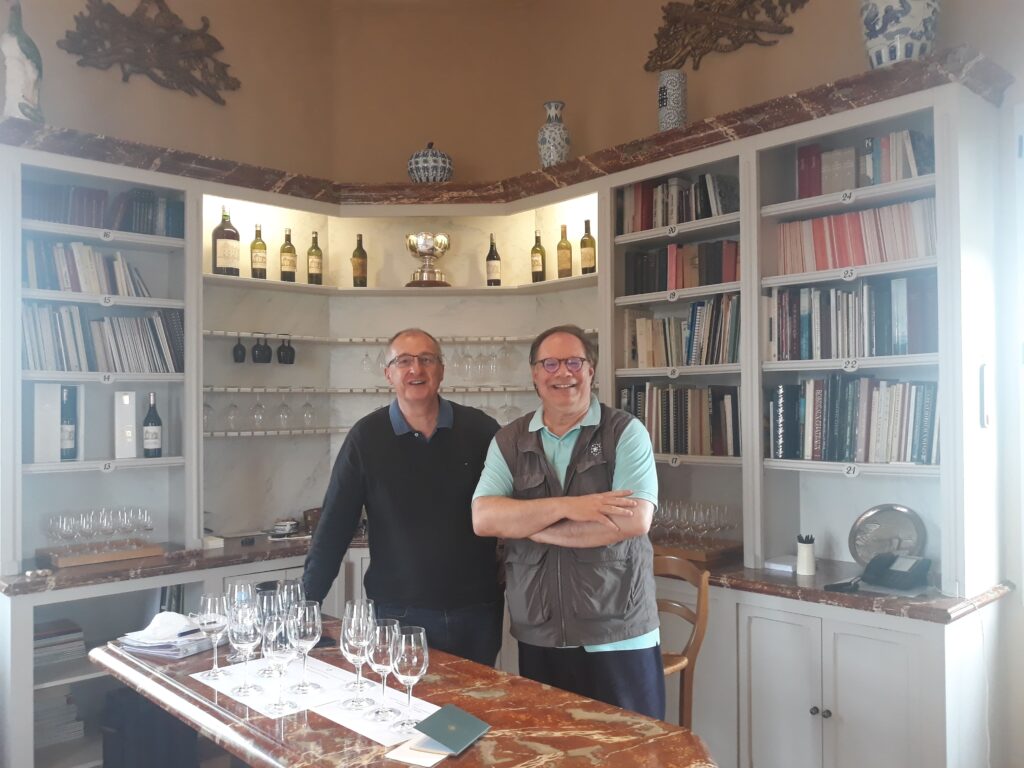
2019 Le Clarence du Haut-Brion 93-96
Deep red. Very pretty aromas of spicy red fruit red fruit and smoky coffee reduction on the nose and in the mouth, complicated by a dusting of minerals. The tannic architecture of this Le Clarence is very impressive, one of the most austere but noble versions of this wine I have memory of at a similar stage of development. This very long, deep, rich and dense wine is a real knockout. I was shocked to learn that this is a 72.8% Merlot,16.3% Cabernet Franc and 10.9% Cabernet Sauvignon blend: funnily enough (but consistent with the vintage’s weather pattern), despite this Le Clarence boasting almost 73% Merlot and 15% alcohol, it is not at all round and easygoing, but is rather very structured and quite austere. This beauty is by no means a “second wine” and will repay cellaring handsomely.
2019 Chateau Haut-Brion Pessac-Léognan 97-100
Beautiful deep red. The captivating nose combines blackcurrant, red cherry, marzipan, menthol, cocoa, cherry wood, tar and licorice. In the mouth, there is an uncanny combination of sweetness and penetrating power, with ripe acidity framing and lifting the fine-grained, downright silky flavours of red and blue fruits, coffee and sweet spices. The very long, slowly rising and highly focused finish conveys an impression of energy and great finesse, not to mention the structure for a graceful evolution in bottle. A real winemaking tour de force, I would have never have guessed this had almost 15% alcohol (actually, 14.6%). The absolutely sublime 2019 Haut-Brion is a 48.7% Merlot, 43.2% Cabernet Sauvignon, and 8.1% Cabernet Franc blend, with 50% of the juice making it into the grand vin. It is an absolutely knockout wine, and my favourite 2019 Bordeaux: in fact, for me the 2019 Haut-Brion is the left bank wine of the vintage. Congratulations are truly in order for a fantastic job done by the stellar team of the “Jean-Philippes” (Delmas and Masclef).
Haut-Madrac.
2019 Chateau Haut-Madrac Haut Médoc 87-90
Bright dark ruby. Fresh and clean aromas and flavours of dark fruit and herbs, with a chocolate undertone. Ripe and round but not much complexity presently, this comes across as simple and not overly long: three or four years of further aging might help it fill out more, by gaining volume and a little more depth. A blend of 56% Cabernet Sauvignon and 44% Merlot.
La Mission Haut-Brion.
2019 La Chapelle de La Mission Haut-Brion 92-94
Good full ruby. Very ripe notes of black fruit (cherry, plums) on the nose and in the mouth are complemented by herbs and earth tones. Closes long and smooth, with nicely persistent herb and black fruit echoes. Very fresh and juicy, this super smooth La Chapelle offers great drinkability already at this young age. It is a remarkably different wine from Le Clarence de Haut-Brion, far more than the differences in the two blends would have you think (the 2019 La Chapelle de La Mission Haut-Brion is a 50.1% Merlot, 45.5% Cabernet Sauvignon, and 4.4% Cabernet Franc blend).
2019 Chateau La Mission Haut-Brion Pessac-Léognan 96-99
Fully saturated ruby. Intense aromas of violet, blackcurrant and sweet spices just soar out of the glass; I found this to be a really explosively perfumed La Mission. Then beautifully delicate in the mouth, with very pure dark berry, mineral and cedar flavours and a suave gentle texture; not nearly as structured as some past vintages of La Mission, this is an absolutely beautiful, extremely well-balanced wine. A blend of 53% Merlot, 39.5% Cabernet Sauvignon, and 7.5% Cabernet Franc, like at its stablemate Haut-Brion, 50% of the harvest made it into the grand vin.
Lafite-Rothschild.
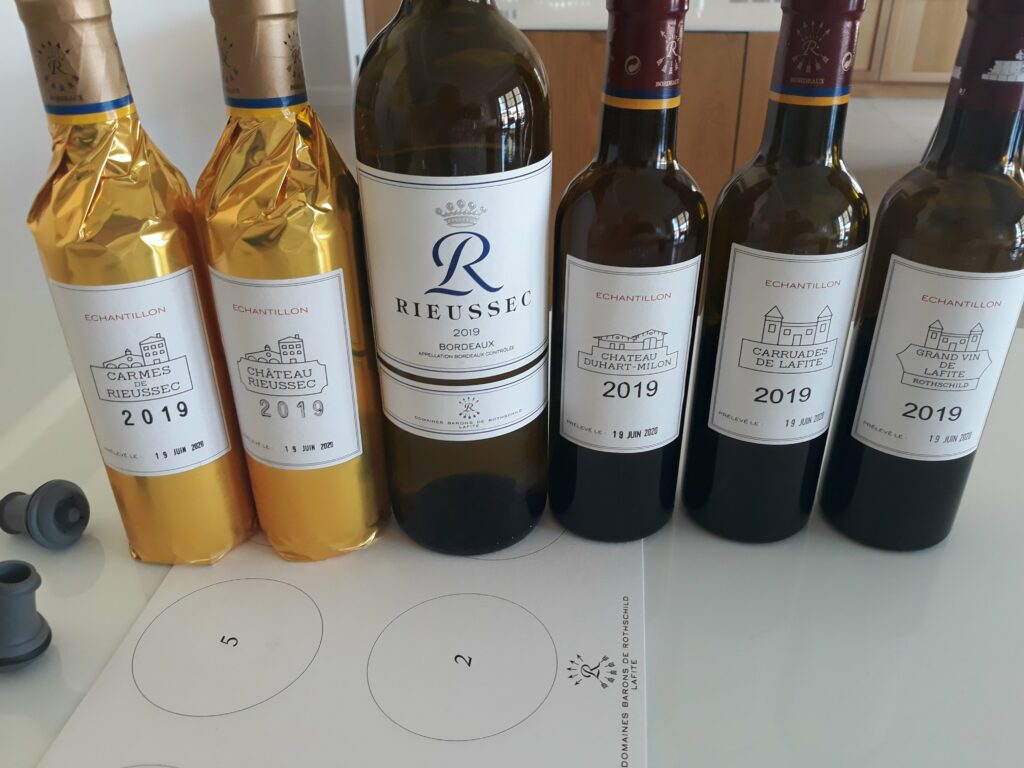
2019 Duhart-Milon Pauillac 89-92
An easygoing, slightly chunky red that is not the exactly the last word in refinement but quite lovely and pleasant nonetheless, it boasts fleshy red fruit and herbal nuances and a long tactile finish. This is 70% Cabernet Sauvignon and 30% Merlot.
2019 Carruades de Lafite Pauillac 92-95
Red fruit, violet, noble cocoa, and spices on the nose and in the mouth: even if it makes up only 5% of the total blend (68% Cabernet Sauvignon, 27% Merlot, and 5% Cabernet Franc), the Cabernet Franc really stands out. Finishes long and clean, with silky tannins. Winelovers might find it interesting to know that there really is a vineyard plot at Lafite called Carruades, but the grapes from this parcel actually go in the grand vin, not the Carruades de Lafite! i
2019 Chateau Lafite-Rothschild Pauillac 95-98
Deep, luminous ruby colour. Mint, violet, cedar, and blackcurrants on the nose and in the mouth. Dense but smooth, this very elegant red finishes long and silky-smooth with fresh and suave reminders of cedar and violet. A 94% Cabernet Sauvignon, 5% Merlot, and 1% Petit Verdot blend. The Grand Vin was produced from only 40% of the harvest, and 38 hL/ha yields.
Lafon-Rochet.

2019 Lafon Rochet Saint-Estèphe 94-96
A beautifully suave, dense Lafon-Rochet, with intense aromas and flavours of dark plum, cassis, minerals and sexy spices. You can tell there is real density and nobility of tannin min this 2019, but the wine, as good as it is (and it really, really is) needs to increase the complexity so as to score even higher. For example, I think a touch of Cabernet Franc would add aromatics and further complexity here, but I know owner Michel Tesseron worries it might have a dilutional effect. This is a 65% Cabernet Sauvignon, 30% Merlot, and 5% Cabernet Franc blend. Lafon-Rochet is magically situated on beautiful deep gravel soils and gravels on clay with vines that are on average 40 years old. The Cabernet Sauvignon was harvested October 2-11, and the Merlot between September 25 and October 1. The wine spent 12 months in barrel (35% new oak). One of the best grand vins from this property in some time (Jean-Claude Berrouet, ex-technical director at Petrus and other storied properties for 40+ years, consults and I’d say the team of Michel and Basile Tesseron along with Berrouet make a pretty unbeatable combination wine-wise).
2019 Chateau Lagrange Saint-Julien 92-95
Moderately saturated bright ruby. Very perfumed and gently ripe, this sweet, fresh Lagrange has sneaky concentration and noteworthy precision to its violet and dark berry aromas and flavours complicated by minerals and exotic herbs. The aftertaste is refined and nicely persistent.
Langoa-Barton.
2019 Chateau Langoa-Barton Saint-Julien 89-92
Deep ruby. The reticent nose hints of blackberry, blackcurrant, cedar and herbs. More open and forward in the mouth: very juicy and fruity on entry, but turns tight and slightly tough in the middle finishing long but with slightly aggressive tannins. There is noteworthy purity of fruit but the wine comes across currently as somewhat angular and harsh. Although this just isn’t much fun right now, I think the tannins are noble and therefore chances are that this will one day smoothen out. Clearly, this interesting and somewhat unusual Langoa-Barton, in that it is normally a slightly more approachable wine even at this tender age, will require plenty of patience and a good cellar. The 2019 is a 67% Cabernet Sauvignon, 26% Merlot, and 7% Cabernet Franc blend.
Lascombes.
2019 Chateau Lascombes Margaux 86-89
Moderately saturated ruby. Clean aromas and flavours of chocolate-covered dark cherry, cassis, spices and coffee, plus a strong whiff of vanillin oak. Much less overripe than the wines that typified this estate’s output in the first decade of the twenty-first century, but over-extraction remains a problem, with an astringent quality on the long back end which features hints of almonds and then a slightly bitter note. In a hot year with the potential for high alcohol, extraction techniques such as pumping over, if performed too aggressively, can lead to too much extraction from the pips, something that invariably leads to the formation of are at first almond reminders, then bitter ones. I was surprised by the high percentage of Merlot in the blend (the 2019 Lascombes is 50% Cabernet Sauvignon, 45% Merlot, and 5% Petit Verdot) but obviously they must have been happy with how this grape performed at Lascombes in 2019.
Latour.
2019 Pauillac 90-93
Maybe the best, and if not the best, certainly the most powerful yet balanced third wine from Latour ever? This knockout wine, considering its pedigree (but it’s still a product of Chateau Latour, so the pedigree really ain’t that bad) is rich, nicely spicy and smooth. This will be ready to drink in 5 years and ought to deliver huge amounts of pleasure. The 2019 Pauillac represents about 30% of the year’s total estate production (and 2019 was a generous year, the biggest crop since 2007: in fact, the yield was of 47 hl/ha, when normaly it is closer to 40). is a 72% Cabernet Sauvignon, 20% Merlot, 6% Cabernet Franc and 2% Petit Verdot blend.
2019 Les Forts de Latour Pauillac 90-93
The 2019 Les Forts de Latour is characterized by lovely tannins that are youthfully chewy but will resolve splendidly with appropriate cellaringing. It’s not the fruitiest Les Forts de Latour I have memory of, even at this young stage of development, but finishes long and clean with delicate spiciness.
2019 Chateau Latour Pauillac 95-98
Lovely deep ruby colour. But really, this is a beautiful wine from start to finish, with also pretty aromas and flavours (licorice, violet, blackcurrants) that are pure, long, clean and precise. Nobly tannic, this strapping, brooding young wine will need plenty of time The blend of the 2019 Latour is 92.5% Cabernet Sauvignon and 7.5% Merlot; Jean Garandeau, the very talented Sales and Marketing director at Artémis Domaines (Chateau Latour, Chateau Grillet, Domaine d’Eugenie, Eisele Vineyard) me that the team felt that their Merlot was more of Forts de Latour quality level rather than Latour’s, and this is why there was so little of it used to make the 2019 grand vin.
2015 Pauillac 90
The 2015 Pauillac wine from Chateau Latour the venerable property’s third wine) is a very charming, ripe, round and smooth little number that left me smiling from the beginning to the end of the tasting (that’s how good it is). It’s an extremely successful Cabernet Sauvignon, 42% Merlot and 4% Petit Verdot blend.
2014 Les Forts de Latour Pauillac 91
Very much in the style of the 2014 vintage’s profile of mostly red fruit and fresher, this very classic long Forts de Latour offers nuances of red fruit and mushroom, complemented by balsamic oils and menthol, that are nicely focused and crisp. It is a 71% Cabernet Sauvignon and 29% Merlot blend.
2012 Chateau Latour Pauillac 94
Plenty of woodsy underbrush, lavender and herbs plus a little spiciness characterize the 2012 Latour, which will not go down in history as one of the fruitiest wines from this storied property. Finishes saline and tactile. This has always been a fairly open vintage for Latour, and though ready to drink already now, it will keep. The 2012 Latour is a 90% Cabernet Sauvignon, 9.5% Merlot, and 0.5% Petit Verdot blend.
Léoville Barton.
2019 Chateau Léoville Barton Saint-Julien. 93-96
Deep ruby with inky tinges. Big, brooding wine with reticent but very pure and very classic Bordeaux aromas and flavours of cassis, cedar, spicebox and graphite. Nicely textured and suave, this strikes me as continuing the recent trend of Leoville-Barton wines that are slightly rounder and smoother than the wines of the last part of the twentieth century and beginning of the twenty-first that were slightly unyielding at a very young age. A 94% Cabernet Sauvignon and 6% Merlot blend.
Lynch-Moussas.
2019 Les Hauts de Lynch-Moussas Pauillac 88-91
Luminous dark ruby-red. Fresh aromas and flavours of small dark fruit, graphite and coffee. Enters nicely supple but not soft, then showcases lovely purity while boasting very good length for a second wine. Not especially complex, but so much fun to drink!. A 59% Cabernet Sauvignon and 41% Merlot blend.
2019 Chateau Lynch-Moussas Pauillac 91-94
A blend of 73% Cabernet Sauvignon and 27% Merlot, this is one of the finest young Lynch-Moussas I recall tasting at a similar stage of development: how appropriate, given that 2019 marks the 100 year ownership of this property by the Casteja family (the bottle sports a lovely new label celebrating the 100 year anniversary). Never an especially powerful or structured but rather a gently refined, delicate wine (which is exactly how it should be, given the terroir of this section of Pauillac), Lynch-Moussas has nonetheless picked up a bit of welcome volume and flesh in recent years. That fact recognized, this Lynch-Moussas is still remarkably easy to drink; all those who enjoy elegant, sleek, cooler styled Cab-Merlot blends will greatly enjoy this wine’s perfumed blackcurrant and flinty notes, not to mention the clean, vibrant, floral and long finish.
Margaux.
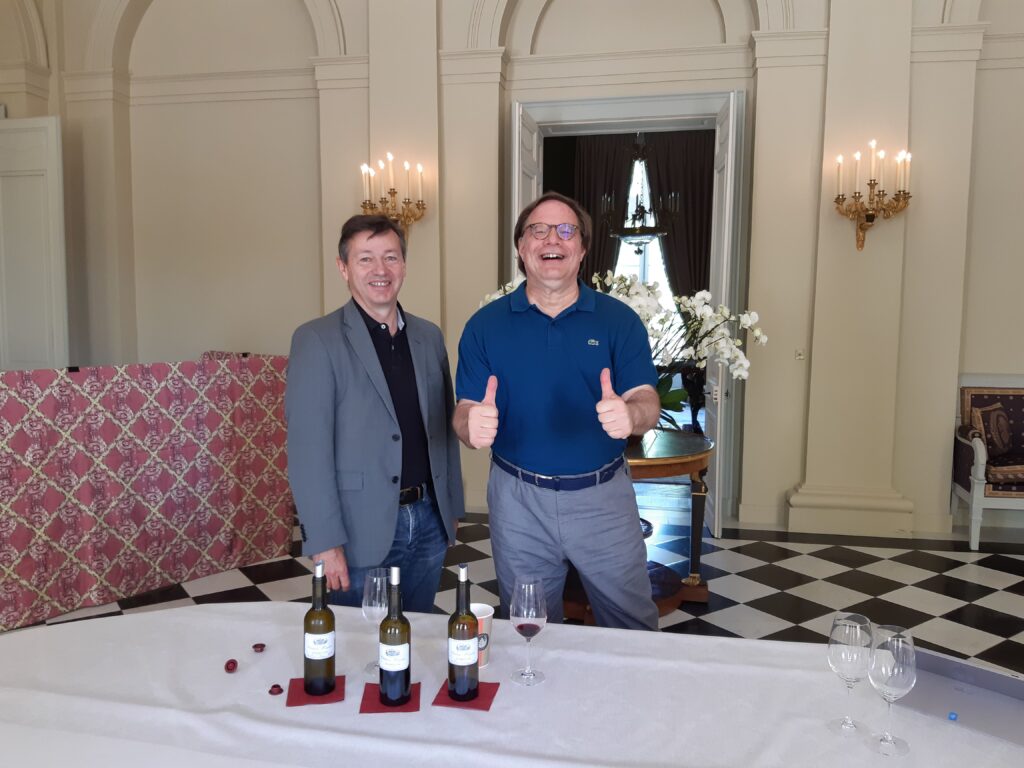
2019 Pavillon Rouge Margaux 94-96
Bright red-ruby. At once dense and silky, but also fresh and very fruity, this finishes long and vibrant with captivating precision. An outstanding, truly lovely wine that is a 76% Cabernet Sauvignon, 19% Merlot, 3% Petit Verdot, and 2% Cabernet Franc blend that strikes me as being perhaps the best Pavillon Rouge ever.
2019 Chateau Margaux Margaux 96-99
Fully saturated ruby. Slightly reticent on the nose but with aeration unleashes boatloads of cassis, herbs and coffee. Magically dense, with beautifully fine-grained tannins and rich suave fruit echoes that leave a very unctuous but refined mouthfeel. The memorable 2019 Chateau Margaux is a 90% Cabernet Sauvignon, 7% Merlot, 2% Cabernet Franc and 1% Petit Verdot blend. Note the Merlot was picked before the September rains while the Cabernet Sauvignon was picked between October 1 and October 10 (so well after the rain which hit on September 22 and 23). General director Philippe Bascaules, with whom it is always a great pleasure to taste with and to listen to, told me that in 2019 the Cabernets gave very fruity but elegant wines while the Merlots gave structure and size, and so the assemblage that gave the finished Chateau Margaux of 2019 was of two very different wine styles.
Montrose.
2019 La Dame de Montrose Saint-Estèphe 90-93
Very floral and very spicy, this elegant red is lifted by ripe acidity accentuated by noteworthy saline bite. La Dame is made from the same vineyard plots as Chateau Montrose: at the end of the vinification the team tastes through the lots (for example this year they had eight different lots to choose from and only about 37% went into the grand vin). The 2019 is a blend of 48% Cabernet Sauvignon, 45% Merlot, 3% Cabernet Franc and 4% Petit Verdot blend normally this wine has an=bit more Merlot than the grand vin, but not in 2019, because the property was very happy with its Merlots this year.
2019 Montrose Saint-Estèphe 93-96
The 2019 Montrose is a beauty, boasting intense aromas and flavours of violet, candied blueberries, plums and blackberry juice nectar. The finish is long lively and smooth. 64% Cabernet Sauvignon, 30% Merlot, 5% Cabernet Franc and 1% Petit Verdot blend is this year’s blend.
Mouton-Rothschild.
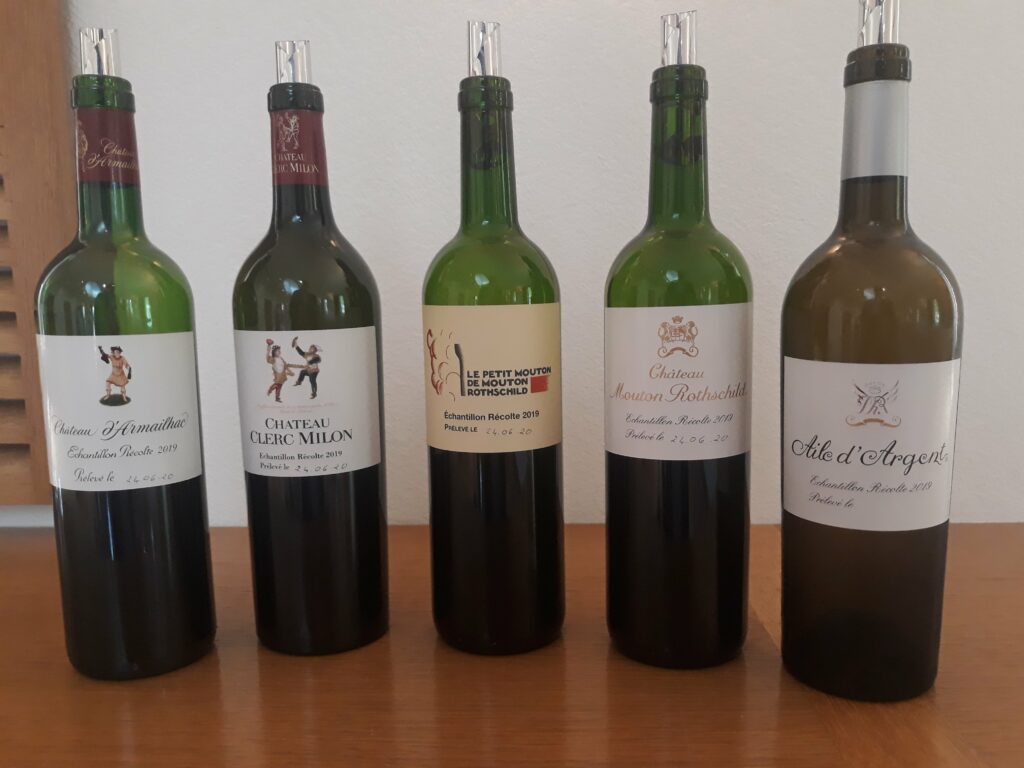
2019 Le Petit Mouton de Mouton Rothschild Pauillac 92-94
An extremely successful 68% Cabernet Sauvignon and 32% Merlot blend, this very spice- and herb-accented (white pepper, cumin, nutmeg, and potpourri), rich and round wine boasts lovely sweetness to its dark fruit aromas and flavours (blackberry, blackcurrant) and an almost unctuous texture. Truly beautiful for a second wine (in fact, I’m doing this knockout wine a real disservice in calling it as such), this is in fact one of the best young Petit Mouton’s I recall tasting at a similar young stage of development.
2019 Chateau Mouton Rothschild Pauillac 92-95
At 90% of the blend, the 2019 Mouton Rothschild boasts one of the highest percentages of Cabernet Sauvignon ever (the 2019 Mouton is a 90% Cabernet Sauvignon, 9% Merlot, and 1% Petit Verdot blend) and the variety clearly dominates the wine’s organoleptic profile, exuding notes of graphite, tobacco, cedar box and violet. Personally, I found the cedar note to be especially strong, and ook forward to it dissipating somewhat as the wine matures in bottle. Less sweet and sexy than the wildly successful 2019 Petit Mouton, this somewhat angular and youthfully chewy Mouton needs plenty of time in the cellar before approaching anything near drinkability. My tasting left me a little perplexed: one bottle was not right, with a second seemingly a little better, but overall, I was left wondering. Yes, other wine writers have gone on record that this is an outstanding vintage for Mouton, and theirs are certainly perfectly respectable views; but no, I do not believe that the 2019 Mouton will go down in history as one of this storied property’s finest hours. If nothing else, the growing season’s climate and rainfall data, plus Mouton’s beautiful gravel beds, should inspire a little caution, rather than tail wagging and knee-jerking in positive fashion just because of the label.
Palmer.
2019 Alter Ego Margaux 94-97
The best Alter Ego ever? I definitely think so, and in my books, it’s not even close. The 2019 Alter Ego is at the very least the equivalent of a Supersecond, so that tells you just how good it is. Fleshy, sweet and very fruity, with varietally accurate and very focused aromas and flavours of coffee and cocoa complementing blackcurrant nuances this elegant wine really does seem like it’s a product of a low fermentation temperature (general director Thomas Duroux told me it rarely if ever is allowed to creep up above 26 degrees Celsius, while it’s 28 degrees Celsius or more for Palmer). The blend of this knockout 2019 Alter Ego is 51% Merlot, 40% Cabernet Sauvignon and 9% Petit Verdot.
2019 Chateau Palmer Margaux 95-98
Fully saturated ruby. Very deep and austere nose (much less immediate but also more complex than that of its 2019 Alter Ego stablemate) of blackcurrants, blackberries, flint, cedar and chocolate. Still very closed and tight, coming across as a little angular presently but improves after a little aeration, revealing noteworthy nobility, density and complexity to the flavours that are very similar to the aromas. An aristocratic, youthfully austere Palmer that has a log life ahead, the 2019 is a 53% Cabernet Sauvignon, 43% Merlot, and 4% Petit Verdot blend. Palmer’s general director Thomas Duroux told me they picked the Merlot before the rains, while the Cabernet Sauvignon was still hanging on the vines, but that the light rain actually helped the Cabernet Sauvignon reach better physiologic ripeness by prolonging its hang time.
Pontet-Canet.
2019 Chateau Pontet-Canet Pauillac 92-95
Very floral and almost downright aromatic in its notes of cinnamon, star anise, hibiscus tea, and Sichuan black pepper, this is light and lively yet boasts also sneaky concentration and depth. This really blossomed with a little aeration. It is a 65% Cabernet Sauvignon, 30% Merlot, 3% Cabernet Franc and 2% Petit Verdot blend, made from yields of 30-35 hl/ha.
Pedesclaux.
2019 Chateau Pedesclaux Pauillac 86-89
Dark ruby. Violet and black fruit aromas and flavours are initially very pretty and expressive, complicated by cedar and licorice notes, but a rising green note takes over in the middle and on the finish. The green note and slightly gritty tannins make me wonder if full physiologic ripeness was achieved here. The 2019 Pedesclaux is a 72% Cabernet Sauvignon, 20% Merlot, 6% Cabernet Franc and 2% Petit Verdot blend.
Pichon Baron.
2019 Chateau Pichon Baron Pauillac 95-98
Nearly impenetrable inky-ruby colour. Then very closed, only hinting at lavender, violet, blackberry, cassis, cedar, Asian spices and vanilla on the nose. Then also very tight and shut down in the mouth too, with dark plum, chocolate and coffee flavours nicely framed by an immense tannic skeleton. Closes long and smooth with repeating floral and spicy reminders. An absolutely massive wine like I don’t believe I have ever tasted from Pichon Baron, the 87% Cabernet Sauvignon and 13% Merlot blend is the highest ever recorded percentage of Cabernet Sauvignon for the property’s grand vin. This wine ought to age forty-fifty years with the utmost ease.
Pichon Comtesse Lalande.
2019 Chateau Pichon Comtesse Lalande Pauillac 93-96
Luminous ruby colour. Floral nuances complement the easygoing aromas and flavours of juicy red cherry, berries and sweet spices. Round and smooth, with a really silky texture and lovely floral and minty lift on the long lively finish. Only 50% of the harvest was used to make the grand vin (the total yield hovered around 42 hl/ha). A blend of 71% Cabernet Sauvignon, 23% Merlot, and 6% Cabernet Franc, there was no Petit Verdot included in the 2019 blend because the variety was especially stressed by the 2019 growing season’s climate.
Pouget.
2019 Chateau Pouget Margaux 88-91
Deep ruby. Strikes me as being a little overripe on the nose, then smooth and clean in the mouth with flavours of dark berries, ink and graphite that echo the aromas on the nose. Youthfully chewy, but less sweet and round than its stablemate Boyd-Cantenac, this will need lots of patience and a good cellar to show all its got to offer. Right now the tannins concern me a little, but perhaps time will take the edge off them.
Prieuré-Lichine.
2019 Chateau Prieuré-Lichine Margaux 93-96
Good full ruby. Captivating aromas of dark berries, blue plum, cedar, graphite, minerals and violet. Then very pure and precise flavours similar to the aromas, with an harmonious acid spince anmd polished tannic spine providing support and nicely extending the flavours on the long clean refreshing back end. A knockout, this is, if not the best young Prieuré-Lichine I have tasted in the last thirty years then certainly one of the top three, I just can’t say enough good things about this 62% Cabernet Sauvignon, 35% Merlot, and 3% Petit Verdot blend; in many respects, it is for me one of the two 2019’s left bank Bordeaux red wines of the vintage (the other being Haut Brion, so you realize the company Prieuré-Lichine is keeping in 2019).
Rauzan Gassies.
2019 Chateau Rauzan-Gassies Margaux 91-94
Vibrant ruby. Notes of blackberries, blueberries, flint and violet just jump out of the glass. Really lovely, this very friendly, smooth and long wine is one of the better Rauzan-Gassies I have tasted at a similar stage of development. Offers a ton of early drinking charm, but will age and improve for twenty years without problems. A 72% Cabernet Sauvignon and 28% Merlot blend, about 10% press wine was used to add a little structure and firmness to this wine’s soft, almost too-approachable fruity disposition. I loved this!
Rauzan-Ségla.
2019 Ségla Margaux 89-92
A very immediate, round, supple sweet and lovely wine, this is a very successful easygoing second wine. The 2019 Ségla is a 62% Cabernet Sauvignon, 36% Merlot, 1% Cabernet Franc and 1% Petit Verdot blend that was aged 18 months in 20% new oak.
2019 Rauzan- Ségla Margaux 91-94
Fully saturated ruby. Extremely floral nose, with notes of lavender and iris dominating the nose and the mouth, complemented by hints of star anise, dark plum and blackberry. Closes long, clean and fresh, not to mention smooth, but there’s a trace of dilution in the middle. This 62% Cabernet Sauvignon, 35.5% Merlot, 2% Petit Verdot and 0.5% Cabernet Franc blend was aged 18 months in 60% new oak. Winemaker Nicolas Audebert, who came to Rauzan-Ségla after having worked at Krug and for LVMH in South America (where he made Cheval des Andes) couldn’t have picked a better time to move given that he hit the ground running with the excellent 2015 vintage, followed by the outstanding ’16 and ‘18. Not as concentrated as the rather extreme 2018, the 2019 is rather more of an ideal crossing of what the 2015 and 2016 Rauzan-Ségla might taste like.
Talbot.
2019 Chateau Talbot Saint-Julien
Finishes long but a little astringent. I’m a big fan of Jean-Michel Laporte, who oversaw the making of some amazing wines at La Conseillante in Pomerol (some of that estate’s best wines of all time in fact), then spent a few years as a wine broker before arriving at Talbot in the 2018 vintage. With his arrival, I’m expecting great things from Talbot in the years to come. The 2019 Talbot is a 69% Cabernet Sauvignon, 26% Merlot, and 5% Petit Verdot blend.
Tronquoy-Lalande.
2019 Tronquoy-Lalande Saint-Estèphe 88-91
Very perfumed aromas of violet and cassis, with saline and slightly chunky fruit flavours in the mouth. Finishes with good length but perhaps just a touch rustic. Perhaps time will help the tannins smoothen out. Bought in 2006 and replanted almost immediately, the vines average 35 years of age. In 2019, this is a 50% Cabernet Sauvignon, 44% Merlot, and 6% Petit Verdot blend.

 中文
中文

